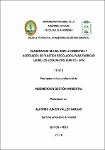| dc.contributor.advisor | Bardales Manrique, Jorge Enrique | |
| dc.contributor.author | Valles Vargas, Alfonso Junior | |
| dc.date.accessioned | 2017-04-06T16:53:55Z | |
| dc.date.available | 2017-04-06T16:53:55Z | |
| dc.date.issued | 2016 | |
| dc.identifier.uri | http://repositorio.unapiquitos.edu.pe/handle/20.500.12737/4363 | |
| dc.description.abstract | El presente estudio de Investigación se desarrolló en la ciudad de Iquitos Universidad Nacional de la Amazonia Peruana – Ciudad Universitaria de Zungaro Cocha, en el área del Centro de Investigación de Vacunos; Ubicado a 45 minutos de la ciudad de Iquitos; así mismo se tendrá como centro de acopio al centro poblado de Zungaro Cocha.
El objetivo del presente estudio fue desarrollar ladrillos plásticos de mezcla cementica mediante la incorporación de residuos plásticos procedentes de residuos sólidos inorgánicos domiciliarios y con bajo coste energético y económico.
De los resultados obtenidos tenemos que de los cuatros tratamientos en estudio T1: (1: 1), T1: 7.00 kg cemento; 7.00 kg plástico triturado T2: (1.5: 0.5), T2: 10.5 kg cemento; 3.5 kg plástico triturado, T3: (1.75: 0.25), T3: 12.25 kg cemento; 1.75 kg plástico triturado, T4: (1.80: 0.20). T4: 12.60 kg cemento; 1.40 kg plástico triturado, se sometieron a pruebas de Humedad, Absorción, Carga y Comprensión con el fin de observar el comportamiento de cada una de ellas.
Los cuatro tratamientos se comportaron de forma totalmente diferente en el incremento de humedad, proceso basado en poner por 24 horas en agua a los ladrillos, tras un proceso previo de secado; donde T4, y T3 muestran una ganancia de humedad del 5% de forma similar, esto está influenciada por la compactación de los ladrillos por el contenido de cemento en ellos, que los hace de baja calidad, en comparación a los tratamientos T1 y T2 en los cuales el contenido de concreto es menor y mayor contenido de plástico es mayor donde el contenido de humedad es mayor caso T1 con el 23%.
El nivel de absorción en los cuatro tratamientos fue totalmente diferente altamente discrepantes entre sí, con valores que van de 23% para T1, 8% para T2, 5.3% para T3 y T4 con 5.5% de humedad respectivamente.
En cuanto a la capacidad de carga, el tratamiento que presento mejor comportamiento fue el tratamiento T4 con el 9,32 Ton, antes de la deformación y/o ruptura del ladrillo, siendo el peor el T2 con la carga mínima de 4.87 Ton.
Basado en la Normatividad, Norma E.070, NTP 399.613, NTP 399.605; estos ladrillos tienen una clasificación TIPO LADRILLO I ya que la compresión en menor a 50 Kg/m2, resistencia y durabilidad muy bajas. Aptos para construcciones de albañilería en condiciones de servicio con exigencias mínimas. | es_PE |
| dc.description.abstract | This research study was conducted in the city of Iquitos National University of the Peruvian Amazon - University City Zungaro Cocha, in the area of Cattle Research Center; Located 45 minutes from the city of Iquitos; Likewise, it will have as a collection center the town center of Zungaro Cocha.
The aim of this study was to develop plastic bricks cementica mixture by incorporating plastic household waste from inorganic solid waste, low energy and cost.
Of the results obtained we have of the four treatments in study T1: (1: 1), T1: 7.00 kg cement; 7.00 kg shredded plastic T2: (1.5: 0.5), T2: 10.5 kg cement; 3.5 kg crushed plastic, T3: (1.75: 0.25), T3: 12.25 kg cement; 1.75 kg crushed plastic, T4: (1.80: 0.20). T4: 12.60 kg cement; 1.40 kg crushed plastic, underwent Moisture, Absorption, Loading and Understanding tests in order to observe the behavior of each of them.
The four treatments behaved in a totally different way in the increase of humidity, a process based on putting 24 hours in water to the bricks, after a previous drying process; where T4 and T3 show a gain of 5% moisture similarly, this is influenced by the compaction of the bricks the cement content in them, which makes low quality, compared to T1 and T2 treatments Which the concrete content is lower and higher plastic content is higher where the moisture content is higher case T1 with 23%.
The level of absorption in the four treatments was highly discrepant completely different each other, with values ranging from 23% for T1, T2 8%, 5.3% for T3 and T4 with 5.5% moisture respectively.
As for the capacity, the treatment showed better performance was treatment with T4 9.32 Ton, before deformation and / or breaking of the brick, T2 being the worst with the minimum load of 4.87 Ton.
Based on the Normativity, Standard E.070, NTP 399.613, NTP 399.605; These bricks have a BRICK TYPE I classification as the compression in less than 50 kg / m2, resistance and durability very low. Suitable for construction of masonry in conditions of service with minimum requirements | es_PE |
| dc.description.uri | Tesis | es_PE |
| dc.format | application/pdf | es_PE |
| dc.language.iso | spa | es_PE |
| dc.publisher | Universidad Nacional de la Amazonia Peruana | es_PE |
| dc.rights | info:eu-repo/semantics/openAccess | es_PE |
| dc.rights.uri | http://creativecommons.org/licenses/by-nc-nd/3.0/us/ | * |
| dc.source | Universidad Nacional de la Amazonía Peruana | es_PE |
| dc.source | Repositorio Institucional - UNAP | es_PE |
| dc.subject | Residuos sólidos | es_PE |
| dc.subject | Plásticos | es_PE |
| dc.subject | Ladrillos | es_PE |
| dc.subject | Mezcla | es_PE |
| dc.subject | Cementos | es_PE |
| dc.title | Elaboración de una mezcla cementica y agregados de plástico reciclados, para fabricar ladrillos ecológicos, Loreto - 2014 | es_PE |
| dc.type | info:eu-repo/semantics/bachelorThesis | es_PE |
| thesis.degree.discipline | Ingeniería en Gestión Ambiental | es_PE |
| thesis.degree.grantor | Universidad Nacional de la Amazonía Peruana. Facultad de Agronomía | es_PE |
| thesis.degree.level | Título Profesional | es_PE |
| thesis.degree.name | Ingeniero en Gestión Ambiental | es_PE |
| thesis.degree.program | Regular | es_PE |


